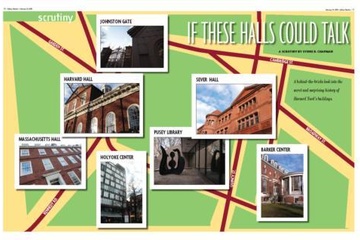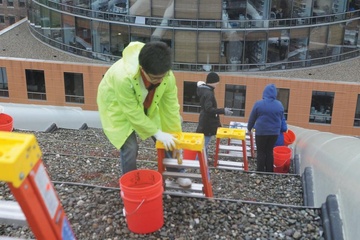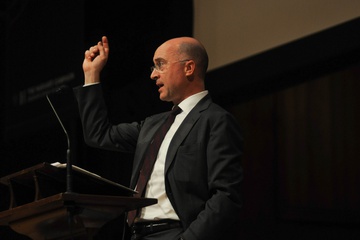I. Two Images
The groundbreaking for Gund Hall in 1969 was supposed to be symbolic, or conciliatory, or something like that.
Fifth graders from Houghton Elementary School—located in another, non-Harvard part of Cambridge—were shipped in for the event to dig the first shovels into the dirt, before construction workers did the real work. This was, of course, meant to showcase the surrounding communities’ evolving relationship with the University, and it made for a damn good photo-op. Harvard at the time still didn’t hire very many black people for big projects like this, so mostly everyone in attendance was white.
Behind the scenes, tensions raged amongst students and faculty, and the planning stages for the building had already been halted multiple times, partly due to the strenuous political environment on campus.
The year 1969 also saw a different sort of groundbreaking: growing civil unrest among college students across the country finally broke out on campus, with the Harvard chapter of the Students for a Democratic Society (SDS) leading the charge.
The common image of Harvard in 1969 is one of University Hall occupied by student protesters speaking out against the Vietnam War, of protesters escorting administrators out of the building. The scene is one of frenzy, exciting but somewhat troubling.
Taken together, these two separate events—the groundbreaking of Gund Hall and the University Hall protest earlier that same year—say something about Harvard’s urge for development, even in times of political discord and community upheavals. In times good and bad, Harvard keeps growing.
In all honesty, some people weren’t sure Gund Hall would ever actually be built. The situation was complicated. But the fifth graders were cute, so people smiled. That’s what you do at these sorts of things.
II. Noise
The University Hall protests more or less amounted to noise. ROTC was ejected from campus, the UC was established, and the Harvard Corporation pretended to listen to students for a while. Noise is good.
Gund Hall’s groundbreaking saw a quieter protest. A petition distributed during the event, signed by 90 students, faculty, and staff, insisted on Harvard’s responsibility to the surrounding community. It said that architects and urban planners should be more interested in solving urban problems, both in Cambridge and abroad. It charged that Harvard didn’t admit enough poor students. It pointed out Harvard’s racist employment policies. Noise.
The construction site, an ugly, inconvenient dirt pit across the street from Memorial Hall, rested on property formerly owned by a local church that Harvard bought out (which Harvard does from time to time). The fifth graders dug into earth that no longer belonged to Cambridge, and people smiled.
III. Building Apart
In theory, the construction of Gund Hall was supposed to unite the Graduate School of Design under a single roof, bringing students together in an intense creative exchange. Maybe it did that, but for some it did nothing to diminish Harvard’s perceived arrogance towards the surrounding communities.
A statement in the petition sums up the building’s place in history nicely. It reads, “The new building ... helps to foster the illusion that our basic problems are caused by inadequate physical facilities, and not by more fundamental issues.”
When the building was completed in October of 1972, one of the architects lamented, “It was a long and painful experience. The attitude at Harvard is that anyone should be thankful for the privilege of working with this University. Well, I’d have to say the building is a success in spite of the GSD.”
Gund Hall might not look much like the rest of Harvard—no red brick—but there is a distinct haughtiness to it. With the staggered roof, ultra-reflective windows, and large overhang on the Quincy Street side, walking past is an all-consuming experience. To top it off, the building is insulated by Memorial Hall, William James, and the Sackler. Gund Hall is not a part of Cambridge.
Things have certainly changed since 1969: Harvard provides substantial financial aid to people who need it, hires minorities, and sometimes listens to students. But there’s still a distinct insular quality to Harvard that’s likely not going away anytime soon. It’s built right into our campus.





